The 8 Most Important SEO Tips for Launching a New Website
A website launch is a huge opportunity to optimize your site for search engines and get ahead of the competition. Here are the most important things to do with SEO when launching a new website.
White-Label SEO Fulfillment for Agencies: The Secret to Scaling Your SEO Services
White-Label SEO Fulfillment for Agencies | Scale Your SEO
In today’s ever-changing digital world, agencies are constantly looking for ways to expand their service offerings, retain clients, and stay ahead of the curve. But here’s the challenge: delivering high-quality SEO services requires expertise, time, and resources that many agencies simply don’t have in-house.
Source: Freepik
This is where white-label SEO fulfillment comes in. It’s the ultimate solution for agencies that want to offer top-tier SEO services without the hassle of building and managing an in-house team. Whether you’re a small agency looking to grow or a large firm aiming to streamline operations, white-label SEO can be your secret weapon.
Let’s dive into what is white-label SEO fulfillment for agencies, and how you can leverage it to scale your business effectively.
What is White-Label SEO Fulfillment for Agencies?
Source: Freepik
White-label SEO fulfillment is a service provided by specialized SEO companies that allows agencies to outsource their SEO work. The best part? The work is delivered under your agency’s brand, so your clients never know it’s being handled by a third party.
From keyword research and on-page optimization to link building and technical SEO audits, white-label providers handle the heavy lifting while you maintain control over client relationships and strategy.
Why White-Label SEO is a Game-Changer for Agencies
Let’s explore below the 4 important reasons why white-label SEO is crucial for agencies.
- Expand your service offerings without the overhead
Not every agency has the resources to hire a full team of SEO experts. With white-label SEO fulfillment, you can offer comprehensive SEO services, e.g. local SEO, eCommerce SEO, or content optimization, without the cost of hiring and training new staff.
- Focus on client relationships and business growth
By outsourcing the technical aspects of SEO, your team can focus on what they do best: building client relationships, closing deals, and growing your agency.
- Deliver expert-level results
White-label SEO providers are specialists in their field. They stay updated on the latest algorithm changes, tools, and strategies, ensuring your clients get the best results possible.
- Scale quickly and efficiently
Whether you’re onboarding a new client or managing a sudden surge in demand, white-label SEO fulfillment allows you to scale your operations seamlessly..
Key Services Offered by White-Label SEO Providers
When you partner with a white-label SEO company, you gain access to a wide range of services, including:
- On-page SEO: Optimizing meta tags, headers, content, and internal linking.
- Technical SEO: Fixing crawl errors, improving site speed, and implementing structured data.
- Off-page SEO: Building high-quality backlinks and managing online reputation.
- Local SEO: Optimizing Google My Business profiles and local citations.
- Content creation: Writing blog posts, landing pages, and other SEO-friendly content.
- Analytics and reporting: Providing detailed performance reports to showcase results to clients.
How to Choose the Right White-Label SEO Partner
Not all white-label SEO providers are created equal. Here’s what to look for when selecting a partner:
- Proven expertise: Check their portfolio, case studies, and client testimonials.
- Transparency: Ensure they provide regular updates and detailed reports.
- Customization: Look for a provider that tailors their services to your agency’s needs.
- Communication: Choose a partner that’s responsive and easy to work with.
- Scalability: Make sure they can handle your agency’s growth and evolving demands.
FAQs
Q. What is the difference between white-label SEO and regular SEO?
White-label SEO is outsourced SEO work that’s rebranded and delivered under your agency’s name. Regular SEO is typically handled in-house or directly by an SEO provider.
Q. Is white-label SEO fulfillment cost-effective?
Yes! It eliminates the need to hire and train an in-house team, saving you time and money while delivering expert results.
Q. Can I customize the services offered by a white-label provider?
Absolutely. Most white-label SEO companies offer customizable packages to meet your agency’s specific needs.
Q. How do I explain white-label SEO to my clients?
You don’t have to! The work is delivered under your brand, so clients won’t know it’s being handled by a third party.
Q. What industries benefit most from white-label SEO?
White-label SEO is versatile and can benefit agencies in any industry, from real estate and healthcare to eCommerce and legal services.
Conclusion
White-label SEO fulfillment is more than just a service. It’s a strategic partnership that empowers agencies to scale their offerings, deliver exceptional results, and focus on growth. By outsourcing SEO tasks to a trusted white-label provider, you can elevate your agency’s reputation, retain clients, and stay competitive in an ever-evolving digital world.
If you’re ready to take your agency to the next level, it’s time to explore the power of white-label SEO. Partner with a reliable provider, and watch your business thrive without the heavy lifting.
Boost Your Website’s Performance with Expert Technical SEO Services
Technical SEO Services | Boost Rankings & Website Performance
If you’re serious about growing your online presence and driving more organic traffic to your website, you can’t afford to overlook technical SEO. It’s the backbone of a high-performing site and ensures that search engines can crawl, index, and rank your content effectively.
Source: Freepik
But here’s the catch: technical SEO isn’t something you can just set and forget. It’s a dynamic process that requires constant attention and fine-tuning to stay ahead of the competition. Whether you’re working with a top technical SEO agency or managing things in-house, understanding how to implement these services correctly can make all the difference in your rankings and site performance.
When done right, technical SEO services can improve site speed, fix indexing issues, optimize site architecture, enhance mobile performance, and much more. Think of it as a detailed tune-up for your website, ensuring everything runs smoothly for both users and search engines. So, let’s break down the most important aspects of technical SEO and why it should be a priority for your website.
8 Key Technical SEO Services You Need to Focus On
Source: Freepik
To dominate search engine rankings and drive organic traffic, focusing on these key technical SEO services is essential.
- Site speed optimization
One of the first things search engines look at is how fast your website loads. Slow-loading pages can lead to higher bounce rates and lower rankings. Optimizing images, leveraging browser caching, and minimizing code can all contribute to a faster, more efficient site.
- Mobile optimization
With mobile-first indexing becoming the norm, ensuring your website is mobile-friendly is no longer optional. A responsive design that adapts to various screen sizes and devices is essential for both user experience and ranking.
- Fixing crawl errors
Search engines need to crawl your site to understand what it’s about. If there are broken links or other crawl errors, search engines might struggle to index your content properly. Identifying and fixing these errors ensures that your site is fully accessible to search engine bots.
- Structured data and schema markup
Adding structured data to your website helps search engines understand your content better. Schema markup can make your site appear in rich snippets or knowledge graphs, boosting visibility and click-through rates.
- XML sitemaps and robots.txt
These files guide search engines on how to crawl and index your site. An optimized XML sitemap ensures that search engines can find all your pages, while the robots.txt file can be used to block unwanted pages from being indexed.
- SSL security
Security is a ranking factor, and Google rewards websites that use HTTPS encryption. Not only does it provide better security for your visitors, but it also shows search engines that you care about user data protection.
- Site architecture and internal linking
A clean, logical site structure helps search engines and users navigate your site with ease. Proper internal linking ensures that link equity is distributed effectively, improving rankings for important pages.
- Content duplication and canonical tags
Duplicate content can harm your rankings. By setting up canonical tags, you tell search engines which version of a page to index, preventing penalties for content duplication.
Why You Need the Best Technical SEO Agency
Technical SEO requires expertise and ongoing monitoring to stay effective. Partnering with the best technical SEO agency can help you stay ahead of algorithm updates, address technical issues quickly, and scale your site’s performance. A dedicated SEO team can provide you with regular audits, fix issues proactively, and implement improvements that align with your long-term SEO strategy.
A well-optimized website means more organic traffic, better user experience, and improved rankings. With the right technical SEO services, you can ensure your website performs at its best and stands out in the competitive digital era!
FAQs
Q. How long does it take to see results from technical SEO?
Results can take anywhere from a few weeks to several months, depending on the complexity of the issues being fixed and how competitive your industry is.
Q. Do I need technical SEO if I already have great content?
Yes, even the best content can go unnoticed if technical issues are preventing search engines from indexing it correctly. Technical SEO helps ensure that your content reaches its full potential.
Q. How do I know if my website needs technical SEO services?
If you’re experiencing slow load times, crawling issues, broken links, or a drop in search rankings, it’s time to consider a technical SEO audit to fix these problems and improve your site’s performance.
Q. Can I do technical SEO myself?
While basic optimizations like fixing broken links or speeding up your site can be done in-house, more complex tasks such as implementing schema markup or resolving crawl issues are best handled by experienced professionals.
Q. How can AEO services help my website?
AEO (Artificial Intelligence-Optimized SEO) services can enhance technical SEO by leveraging AI tools to analyze and optimize site performance, identify trends, and automate tasks like keyword research, making SEO efforts more efficient.
Conclusion
With the right technical SEO strategies in place, you can improve your website’s overall performance and ensure that both users and search engines can access and value your content. Whether you’re looking to handle this in-house or partner with the best technical SEO agency, the goal is clear: optimize your site for long-term success!
SEO Migration: Proven Strategies to Keep Rankings & Traffic Intact
SEO Migration: How to Ensure a Smooth Transition for Your Website
Whether you’re giving your website a fresh new design or transitioning to a completely new platform, ensuring a smooth SEO migration is essential for maintaining your search engine rankings and keeping your traffic steady. A well-executed migration can make all the difference, helping you avoid losing valuable visibility and organic search traffic during the process.
Source: Freepik
The key to success lies in adopting the right strategies that will allow your website to seamlessly make the transition without any negative impact on your SEO performance. Let’s dive into the best practices that will set you up for a successful SEO migration and ensure your site thrives throughout the process.
What is SEO Migration?
SEO migration is the process of transitioning a website or making significant changes to its structure, such as switching domains, altering the URL structure, or redesigning the site. The goal is to maintain or even improve SEO performance throughout the process. A successful SEO migration requires meticulous planning and execution to preserve search rankings, prevent traffic loss, and ensure the site remains optimized for future growth.
Why SEO Migration Matters
SEO migration is critical for websites undergoing any type of major update, such as:
- Website redesigns: A fresh look, improved navigation, or a new CMS.
- Website migrations: Moving to a new platform, hosting, or domain.
- URL structure changes: Updating page URLs or categories.
- Content changes: Updating or removing pages that may impact SEO.
Without a structured migration process, your website might lose valuable organic traffic, damage your reputation with search engines, or face penalties due to improper redirects or broken links.
5 Key Steps for a Successful SEO Migration
Source: Freepik
Here’s how to ensure your website migration goes smoothly and maintains its SEO integrity:
1. Conduct a full SEO audit before migration
Before you begin the migration, start with a comprehensive SEO audit of your current site. This audit will help you identify important pages, high-performing content, and key traffic sources. Key elements to check include:
- Current keyword rankings.
- High-value pages and backlinks.
- Mobile optimization and load speed.
- Any technical issues that need addressing.
A solid audit helps you ensure that your migration process doesn’t negatively affect your current SEO efforts.
2. Map your URLs and set up 301 redirects
When migrating, changes in your website’s URL structure can result in broken links and traffic loss if not handled properly. Mapping out your old URLs to their corresponding new URLs is essential. Use 301 redirects (permanent redirects) to ensure that users and search engines are automatically sent to the new pages.
301 redirects pass most of the SEO value from the old page to the new one, ensuring that you don’t lose your rankings and organic traffic.
3. Optimize on-page SEO during the migration
While migrating your website, take the opportunity to refresh your on-page SEO elements. This includes:
- Title tags and meta descriptions.
- Heading structure (H1, H2, etc.).
- Image alt text and file names.
- Internal linking and content updates.
Make sure these elements are properly optimized for SEO to boost rankings and improve the user experience on your new site.
4. Test & ensure mobile-friendliness and page speed
Google prioritizes mobile-friendly websites in its rankings. As you migrate, ensure that the new site is fully responsive and performs well across all devices. Similarly, improving page load speed is crucial. A fast, mobile-optimized website offers a better user experience, and search engines reward such sites with higher rankings.
5. Monitor and track SEO performance post-migration
Once the migration is complete, keep a close eye on your site’s SEO performance. Use tools like Google Analytics, Google Search Console, and Ahrefs to monitor your website’s rankings, organic traffic, and technical health. Look for:
- Any drops in rankings or organic traffic.
- Broken links or 404 errors.
- Changes in page load speed or mobile performance.
These insights will help you quickly identify and fix issues that may arise after the migration.
FAQs
Q. How long does it take to see SEO results after a migration?
It can take a few weeks to months for search engines to fully crawl and index your new site. Initial ranking fluctuations are normal, but long-term results should be positive with proper execution.
Q. Do I need to hire an SEO expert for my migration?
While it’s possible to handle SEO migration in-house, hiring an experienced professional can save time and reduce the risk of errors that may harm your rankings.
Q. Can I do an SEO migration without losing traffic?
Yes! With the right strategies, like proper URL mapping, 301 redirects, and monitoring, you can retain or even improve traffic during migration.
Q. How does SEO migration relate to website redesign services?
SEO migration ensures your redesign doesn’t harm SEO efforts. By planning properly, you can maintain or enhance search engine visibility while making structural or design changes.
Conclusion
SEO migration is a critical part of any website redesign or migration project. By carefully following the steps, e.g. conducting an SEO audit, setting up redirects, optimizing on-page SEO, and monitoring performance, you can protect your rankings and organic traffic.
If you’re planning a migration, make sure to implement these strategies to keep your SEO intact and ensure long-term success. Ready for your website migration? Start with these expert strategies to keep your rankings intact and watch your site thrive post-migration!
Personal Injury SEO: Proven Strategies to Rank Higher & Get More Clients
Personal Injury SEO: Expert Tips to Improve Your Rankings
If you’re running a personal injury law firm, having a solid personal injury SEO strategy is a game-changer. With so many firms competing for visibility, ranking higher in search results can mean the difference between landing new clients or getting overlooked. The right SEO tactics can boost your online presence, drive qualified leads, and help you stay ahead of the competition. Let’s dive into the key strategies to make your firm stand out.
Source: Freepik
Understanding the Basics of Personal Injury SEO
SEO (Search Engine Optimization) is all about making your website more visible on search engines like Google. For personal injury law firms, SEO involves optimizing your site for keywords that potential clients are searching for, improving your site’s authority, and ensuring a seamless user experience.
A well-optimized website:
- Ranks higher on search engines.
- Attracts qualified leads.
- Builds trust and credibility.
- Increases conversion rates.
Next, let’s break down the SEO process, e.g. finding the right keywords, creating content, fixing technical issues, and building links. Follow these steps correctly, and your site will rank higher and attract the right clients.
- Research Keyword Smartly
Before you start optimizing, you need to know what people are searching for when looking for a personal injury lawyer. Keyword research helps you target the right terms and phrases.
Some high-value keywords include:
- ‘Best personal injury lawyer near me.’
- ‘Car accident attorney free consultation.’
- ‘Slip and fall lawyer in [your city].’
- ‘How much does a personal injury lawyer cost?.’
Use tools like Google Keyword Planner, Ahrefs, or SEMrush to find relevant keywords with good search volume and low competition.
| 💡Quick Tip: While broad keywords like ‘personal injury lawyer’ are competitive, long-tail keywords (e.g., ‘affordable personal injury lawyer in Miami’) can be easier to rank for and attract more qualified leads. |
- Create High-Quality Content
Content marketing is a powerhouse for SEO. Google favors websites that consistently provide valuable, informative, and engaging content.
What to write about?
- Common personal injury claims explained.
- What to do after a car accident.
- How much is my injury claim worth?
- The role of negligence in personal injury cases.
Use case studies & FAQs
Sharing real-life success stories and answering common legal questions can build trust and authority. People want to know how you’ve helped others in their situation.
Source: Freepik
- Build Backlinks the Right Way
Backlinks (links from other websites to yours) are one of Google’s top ranking factors. The more high-quality backlinks you have, the higher your site will rank.
How to get backlinks
- Guest post on legal and industry websites.
- Get featured in local news outlets.
- Partner with other legal professionals.
- Submit to legal directories like FindLaw and Avvo.
Avoid spammy links! Google penalizes websites that try to manipulate rankings with low-quality backlinks.
- Take Advantage of Local SEO
Since personal injury law firms serve local clients, local SEO is critical. Optimizing for local search ensures your firm appears in Google’s Local Pack (the top 3 local search results).
Optimize your Google business profile
- Ensure your name, address, and phone number (NAP) are consistent across directories.
- Add real client reviews, e.g. businesses with positive reviews rank higher.
- Use local keywords like ‘personal injury attorney in [your city]’.
- Upload high-quality images of your office and team.
- Measure Your Success
SEO isn’t a one-time effort. You need to track your progress and adjust your strategy.
Key SEO metrics to monitor
- Organic traffic (Google Analytics)
- Keyword rankings (Ahrefs, SEMrush)
- Conversion rate (leads from website visitors)
- Backlinks & domain authority (Moz, Ahrefs)
Use Google Search Console to check for technical issues like broken links or slow site speed.
FAQs
Q. How long does it take to see SEO results?
SEO takes time. Typically, you’ll start seeing improvements in 3-6 months, but long-term success requires ongoing effort.
Q. Should I hire an SEO agency or do it myself?
If you have the budget, hiring an experienced SEO agency can fast-track your results. However, if you’re willing to learn, DIY SEO is possible with the right tools and strategies.
Q. Is paid advertising better than SEO?
While Google Ads can drive immediate traffic, SEO provides sustainable, long-term results at a lower cost over time.
Q. How can Motor Accident SEO help my law firm?
Motor accident SEO focuses on targeting clients involved in motor vehicle accidents. By optimizing for terms like ‘motor accident lawyer’ or ‘car accident attorney,’ you can attract more clients seeking legal help after an accident, ensuring your firm stands out in local search results.
Conclusion
Personal injury SEO is a must for law firms looking to attract more clients online. By focusing on keyword research, content creation, local SEO, and backlinks, you can improve your search rankings and drive high-quality leads.
Ready to boost your law firm’s visibility? Start implementing these SEO strategies today, and watch your website climb the ranks!
White-Label SEO That Works for Your Agency
How to Choose the Best White-Label SEO Provider for Your Agency
Ever feel like there just aren’t enough hours in the day to handle all your clients’ SEOneeds? You want to deliver results, but building an in-house team? That’s expensive, time-consuming, and honestly, a headache. That’s where white-label SEO comes in.
Source: Freepik
It’s like having an expert SEO team working behind the scenes while your agency takes all the credit. No extra hires, no stress! Just seamless SEO fulfillment that helps you scale without stretching yourself too thin.
Sounds like a win, right? Let’s break down how it actually works and why it might just be the smartest move for your agency.
What Is White-Label SEO?
First things first, let’s talk about what white-label SEO actually is. In simple terms, it’s a service that lets agencies like yours outsource SEO work to experts. They take care of everything, from finding the right keywords to building quality links, while you get to put your agency’s name on the final product. It’s like having a secret weapon that does the heavy lifting while you take the credit.
Why Should You Consider White-Label SEO?
You might be wondering, ‘Why should I even bother with this?’ Well, here’s the deal.
First, it saves you a ton of time. Instead of trying to juggle SEO projects on top of everything else, you can focus on building client relationships and growing your business.
Second, you’re getting real SEO experts on your side. Let’s be honest: not everyone is an SEO pro, and that’s totally fine. A white-label SEO provider gives you access to a team that lives and breathes SEO, so you don’t have to figure it all out yourself.
And then there’s the cost. Hiring a full-time, in-house SEO team can be crazy expensive. With white-label SEO, you only pay for what you need, no overhead & no stress.
Plus, it helps you deliver consistent, high-quality results. By working with SEO specialists, you’re making sure your clients get top-notch strategies that actually work. That means happier clients, better rankings, and a stronger reputation for your agency.
How to Choose Your White-Label SEO Sidekick
Source: Freepik
Alright, you’re on board. But how do you pick the right partner for the job? Here are a few handy tips to help you out:
Hunt for proven track records
Always peek at reviews and case studies. A top-notch white-label SEO crew will have a portfolio packed with wins. Don’t be shy and ask for references. You wanna make sure they can walk the talk.
- Scope out their service menu
Look for a smorgasbord of SEO services. The more they can juggle, the better they can whip up solutions that fit your needs. From on-page magic to technical SEO wizardry, a diverse offering means they can handle any curveball your clients throw.
- Get a grip on pricing and packages
White-label SEO prices can swing from one end to the other, so it’s key to find a partner that plays nice with your budget. Look for a crew offering packages that fit your pocket without skimping on quality. This flexibility means you can line up their services with your pricing and keep your profit train chugging.
- Assess communication and support
Good banter is crucial. You’ll want a provider who keeps you in the loop and offers a helping hand when needed. It’s like having a trusty sidekick guiding your SEO adventure. Frequent updates and open channels for feedback are vital to keeping things smooth and meeting client hopes.
How White-Label SEO Changed the Game for My Agency
Let me spill a quick story. A few years back, my agency was drowning in work. We had more clients than we could handle, and our SEO squad was running ragged. That’s when I decided to give white-label SEO a shot.
It was a game-changer. Not only did it take a load off our shoulders, but it also cranked up our results. Our clients were buzzing with happiness, and we had more time to focus on strategic growth. Plus, teaming up with a white-label provider let us ramp up our service menu fast.
We could dive into new markets we once thought were out of reach. The flexibility and scalability of white-label SEO made it possible to tackle a variety of industries without the hassle of recruiting and training new folks. This clever move not only padded our revenue but also filled our portfolio with a diverse range of successful campaigns.
Common Worries About White-Label SEO
I get it, some of you might be sweating over a few concerns. What about quality control? Will clients catch on? These are valid worries, and addressing them upfront is key.
- Quality control
Pick a provider with a solid quality assurance game. Most reputable companies will have checks to keep things consistent and top-notch. Regular reports and crystal-clear processes show a provider serious about keeping the bar high.
- Client confidentiality
Top white-label SEO companies stick to strict confidentiality pacts. Your clients will never catch wind of someone else doing the heavy lifting. This keeps your agency’s reputation and client trust intact.
- Blending in with your agency
Good providers become part of your crew. They’ll adapt to your ways and work alongside you to smash your clients’ goals. This level of teamwork ensures that service delivery stays smooth and your clients enjoy a seamless experience.
FAQs
Q. What exactly does white-label SEO entail?
White-label SEO involves outsourcing SEO tasks to a third-party provider who completes the work under your agency’s brand. It includes services like keyword searching, content writing, and link building.
Q. How do I make sure quality stays on point with a white-label SEO provider?
To keep quality on point, pick a provider with a rock-solid track record, clear process, and positive reviews. Regular updates and open communication help maintain quality.
Q. Are there risks with white-label SEO?
Like any business move, there are risks, like quality control. But, partnering with a reputable provider with strict processes and NDAs minimizes these issues.
Q. Can I afford white-label SEO services?
It’s often cheaper than hiring an in-house team. Many providers offer flexible pricing to fit different budgets.
Q. Will my clients know I’m using a white-label SEO service?
Nope, the best white-label SEO companies work under confidentiality agreements, ensuring your clients see it as your agency’s work.
Conclusion
There you have it! White-label SEO can be a mighty tool for agencies wanting to expand their offerings without the headache of hiring full-timers. It lets you focus on your forte while making sure your clients get top-tier results.
So, whether you’re a small agency or a seasoned player in digital marketing, give white-label SEO a shot. Who knows, it might just be the missing piece you’ve been looking for.
By diving into white-label SEO, you’re not just outsourcing tasks; you’re supercharging your agency to hit new heights. With added flexibility and expertise, you can take on more clients, explore new markets, and grow your business faster. It’s a savvy move that can reshape your agency’s future, turning challenges into opportunities and dreams into reality.
How to Optimize for SERP Features in 2025
Understanding SERP Features and Their Importance
Before you can optimize for SERP features, it’s essential to know what they are and how they work. These features are the rich results that appear in search engine result pages (SERPs), such as:
- Featured Snippets
- Local Packs
- Knowledge Graph
- People Also Ask
- Image and Video Carousels
- News Boxes
Each of these features presents a unique opportunity to capture more visibility and drive traffic. Let’s break down how you can target each one.
Why Optimizing for SERP Features is Crucial in 2025
In 2025, optimizing for SERP features is more important than ever. These features play a pivotal role in driving organic traffic to websites, as they often occupy prime real estate on the SERP. Furthermore, SERP features significantly influence clickthrough rates (CTR); users are more likely to click on results that are visually appealing or provide quick answers. By optimizing for SERP features, businesses can gain a competitive advantage, positioning themselves ahead of competitors who may not be leveraging these features effectively.
Key SERP Features to Focus on in 2025
Featured Snippets
Featured Snippets are the boxed information at the top of some search results. To optimize for them:
- Identify question-based keywords: Use tools like Ahrefs or SEMrush to discover the questions people are asking in your niche.
- Provide clear, concise answers: Format your content to provide brief answers (40-50 words) to common questions.
- Use structured data: Implement schema markup to help Google understand the context of your content.
- Optimize for the “position zero” opportunity: Create well-structured content that directly answers questions, providing quick value.
Knowledge Panels
Knowledge panels are information boxes that appear on the right side of the SERP, providing users with a summary of information about a brand, person, or topic. Understanding the components of knowledge panels is crucial for enhancing brand visibility. Implementing structured data, such as schema markup, can significantly improve the chances of appearing in knowledge panels, as it helps search engines understand the context of the content.
Local Pack
For businesses targeting local customers, optimizing for the Local Pack (the map and business listings that show up in local searches) is crucial:
- Claim and optimize your Google My Business listing: Keep your contact information, hours, and reviews updated.
- Encourage reviews: Positive reviews increase your chances of showing up in the Local Pack.
- Local keywords: Use location-based keywords throughout your site, in your meta tags, and on your GMB profile.
Leverage the Power of People Also Ask (PAA)
The People Also Ask box provides an opportunity for your content to appear in response to related questions.
- Identify common questions: Use tools like Answer the Public or Google’s own PAA section to identify questions users are asking.
- Provide concise, informative answers: Just like with Featured Snippets, keep your answers to the point and optimize for natural language.
Optimize for Video and Image Carousels:
Visual content is a powerful tool in capturing user attention.
- Use schema markup for images and videos: Add structured data to your videos and images to improve visibility.
- Optimize video titles, descriptions, and tags: Be sure your videos are SEO-friendly and relevant to the topic.
- High-quality visuals: Make sure your images are of high quality and optimized for fast loading times.
Techniques for Optimizing Content for SERP Features
Utilizing Structured Data Markup
Structured data markup is a standardized format for providing information about a page and classifying the content. Its benefits include improved search visibility and the potential to earn rich snippets. Common types of structured data to implement include product, recipe, and article schema. Tools like Google’s Structured Data Testing Tool can help validate structured data, ensuring it is correctly implemented.
Crafting Compelling Meta Descriptions and Titles
Meta descriptions and titles play a crucial role in SERP features, as they are often the first impression users have of a website. Best practices for writing effective meta descriptions include keeping them concise, incorporating relevant keywords, and creating a compelling call to action. Similarly, optimizing titles for better SERP performance involves using clear, descriptive language that accurately reflects the content.
Monitoring and Adapting Your Strategy
Tools for Tracking SERP Feature Performance
To effectively monitor SERP feature performance, various analytics tools are available, such as Google Analytics and SEMrush. Key performance indicators (KPIs) to focus on include organic traffic, CTR, and keyword rankings. Adjusting your strategy based on performance data is essential for continuous improvement and staying ahead in the competitive landscape of SEO.
Staying Updated with SERP Changes
Keeping abreast of SEO trends and updates is vital for maintaining an effective optimization strategy. Resources such as SEO blogs, webinars, and industry conferences can provide valuable insights into SERP feature changes. The role of continuous learning in SEO optimization cannot be underestimated, as it allows content creators to adapt to the ever-evolving search landscape.
FAQs
Q. What sort of links rank higher in search engine results?
High-quality backlinks from authoritative and relevant websites significantly boost your site’s credibility and improve search engine rankings.
Q. In what way can I rank on Google’s top page within a day?
Achieving a top position on Google’s first page within a day is highly unlikely through organic methods. However, utilizing Google Ads for targeted keywords can provide immediate visibility.
Q. Where can I find the SERP features?
SERP features are special elements on Google’s search results page, such as featured snippets, knowledge panels, and local packs. They appear alongside traditional search results to enhance user experience
Q. What’s the greatest method for getting a featured snippet in a SERP?
To secure a featured snippet, structure your content to directly answer common user queries, use clear headings, and format information in lists or tables where appropriate. Implementing structured data markup can also help search engines understand your content better.
Q. Can I rank in a SERP feature without being #1?
Yes, it’s possible to appear in certain SERP features, like featured snippets or ‘People Also Ask’ boxes, without holding the top organic position. This depends on how well your content addresses specific queries and its relevance.
Q. What tools can help with SERP feature tracking?
Tools like SEMrush, Ahrefs, and Moz offer functionalities to track SERP features, monitor your website’s performance, and provide insights into opportunities for optimization.
Conclusion
In conclusion, optimizing for SERP features in 2025 is crucial for enhancing visibility, driving organic traffic, and maintaining a competitive edge. By implementing the strategies discussed, content creators can significantly improve their chances of appearing in prominent SERP features. As the landscape of SEO continues to evolve, staying informed and adaptable will be key to future success in content marketing and search engine optimization.
Ready to boost your rankings and dominate SERP features in 2025? Start implementing these strategies today, and if you need personalized guidance, feel free to reach out. At LazyMetrics, we specialize in SEO strategies that make a real impact. Contact us for a free consultation and let’s take your site to the next level!
How to Rank #1 on Google Maps for Roofing Services in Your Area
Why Google Maps Ranking is Critical for Roofing Businesses
As a roofing business owner, you know how competitive the local market can be. With so many contractors vying for the same customers, standing out is crucial. One of the most effective ways to attract more clients and grow your business is by improving your Google Maps ranking for roofing services. When potential customers search for “roofing services near me,” you want your business to appear at the top of the map pack.

We’ll explore why ranking on Google Maps is essential for roofing businesses and provide actionable strategies to help you climb to the #1 spot. Plus, we’ll share a handy checklist to audit and improve your local rankings. Let’s get started!
Why Google Maps Ranking is Critical for Roofing Businesses
Google Maps has become the go-to resource for local searches. When someone needs a roofing contractor, they’re likely to type in phrases like “roofing services near me” or “roof repair in [city].” These searches often trigger the local map pack, which displays the top three businesses in the area along with their ratings, reviews, and contact information.

Here’s why ranking on Google Maps matters:
- Increased Visibility: Appearing in the map pack puts your business directly in front of potential customers, even if they don’t click through to your website.
- Trust and Credibility: Businesses that rank higher on Google Maps are often perceived as more trustworthy and reliable.
- Higher Conversion Rates: Local searches have high intent—people are ready to hire a roofer. Ranking well means more calls, emails, and job requests.
- Competitive Edge: Many roofing businesses overlook local SEO, so optimizing for Google Maps can give you a significant advantage.
Now that you understand the importance of Google Maps ranking for roofing services, let’s dive into the strategies to help you get there.
Key Strategies to Improve Your Google Maps Ranking
1. Optimize Your Google Business Profile (Formerly GMB)
Your Google Business Profile is the foundation of your Google Maps ranking for roofing services. It’s how Google understands your business and determines whether to show it in local searches. Here’s how to optimize it:
- Complete Every Section: Fill out every field in your GBP, including your business name, address, phone number (NAP), website, hours of operation, and services offered.
- Choose the Right Categories: Select primary and secondary categories that accurately describe your business, such as “Roofing Contractor” or “Roof Repair Service.”
- Add High-Quality Photos: Upload photos of your team, completed projects, and before-and-after shots. Visuals build trust and engagement.
- Use Keywords Naturally: Incorporate keywords like “roofing services near me” and “roof repair in [city]” in your business description and posts.
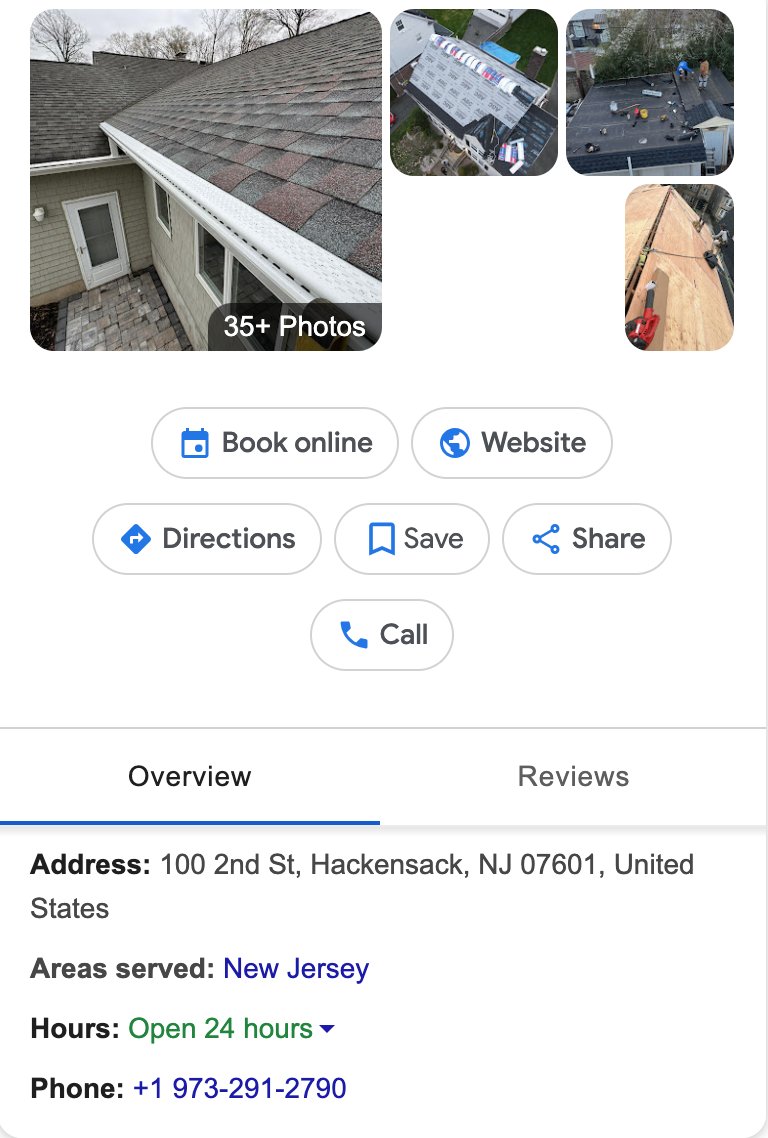
2. Collect and Manage Customer Reviews
Reviews are a critical ranking factor for local SEO for roofers. They also influence potential customers’ decisions. Here’s how to leverage reviews:
- Ask for Reviews: Politely request reviews from satisfied customers. Make it easy by providing a direct link to your GBP review page.
- Respond to Reviews: Reply to all reviews, both positive and negative. Thank customers for their feedback and address any concerns professionally.
- Highlight Positive Reviews: Showcase glowing reviews on your website and social media to build credibility.
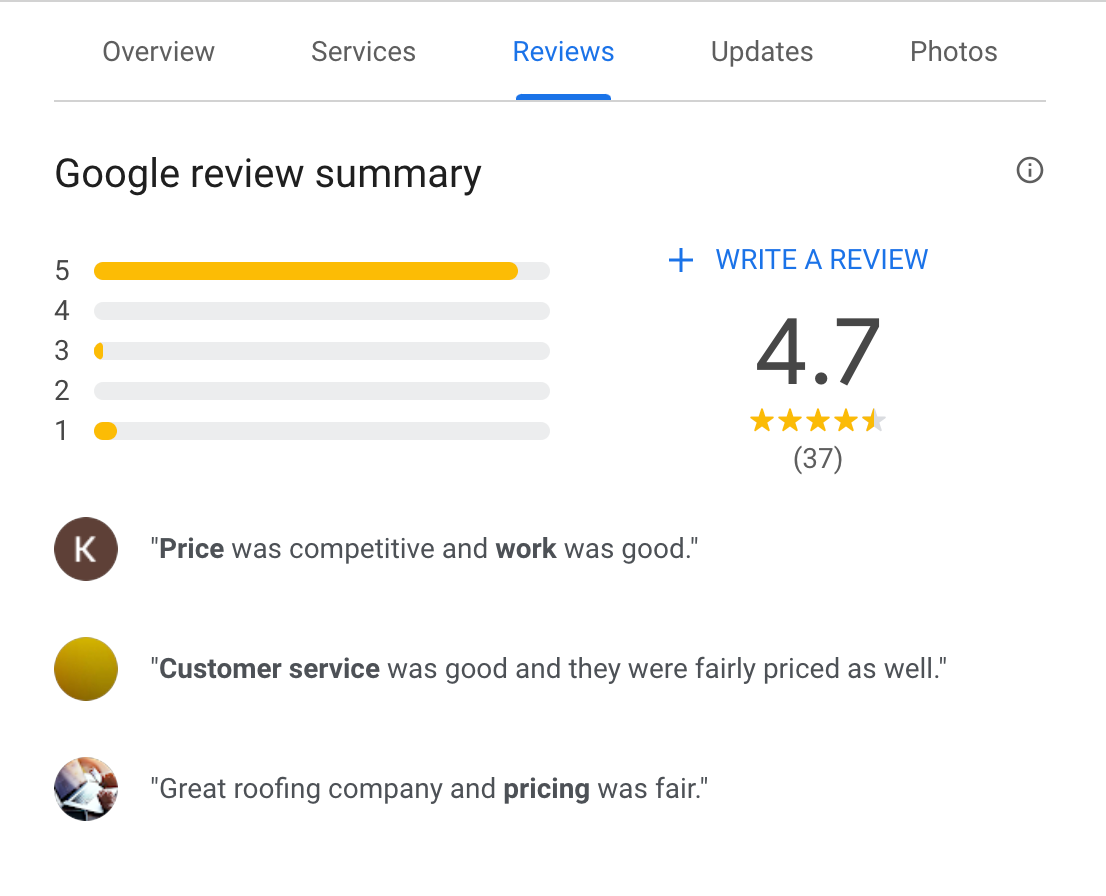
3. Implement Local SEO Techniques
Local SEO Techniques are the backbone of Google Maps ranking for roofing services. Here are some proven tactics:
- Target Local Keywords: Use keywords like “roofing services near me,” “emergency roof repair in [city],” and “residential roofing contractor” in your website content, meta descriptions, and blog posts.
- Create Location-Specific Pages: If you serve multiple areas, create dedicated pages for each location (e.g., “Roofing Services in Dallas”).
- Optimize for Mobile: Most local searches happen on mobile devices, so ensure your website is fast and mobile-friendly.
4. Build High-Quality Local Backlinks
Backlinks from reputable local websites signal to Google that your business is trustworthy and relevant. Here’s how to build them:
- Partner with Local Businesses: Collaborate with complementary businesses, like home builders or window installers, to exchange links.
- Get Listed in Local Directories: Submit your business to directories like Yelp, Angi, and the Better Business Bureau.
- Sponsor Local Events: Sponsorships often come with backlinks from event websites and local news outlets.

Common Mistakes to Avoid
While optimizing for Google Maps ranking for roofing services, avoid these pitfalls and mistakes.
- Keyword Stuffing: Overloading your GBP or website with keywords can hurt your rankings. Use them naturally.
- Inconsistent NAP Details: Ensure your business name, address, and phone number are consistent across all platforms.
- Ignoring Customer Reviews: Failing to respond to reviews or address negative feedback can damage your reputation.
- Neglecting Your Website: Your GBP is important, but your website also needs to be optimized for local SEO.
Google Maps Ranking Checklist for Roofing Businesses
Use this checklist to audit and improve your Google Maps ranking for roofing services:
- Google Business Profile Optimization:
- Complete all profile sections.
- Add high-quality photos.
- Choose accurate categories.
- Use local keywords in your description.
- Customer Reviews:
- Request reviews from happy customers.
- Respond to all reviews promptly.
- Showcase positive reviews on your website.
- Local SEO:
- Target local keywords in your content.
- Create location-specific pages.
- Ensure your website is mobile-friendly.
- Backlinks:
- Build links from local directories.
- Partner with other local businesses.
- Sponsor community events.
- Avoid Common Mistakes:
- Don’t keyword stuff.
- Keep NAP details consistent.
- Monitor and respond to reviews.
- Optimize your website for local SEO.
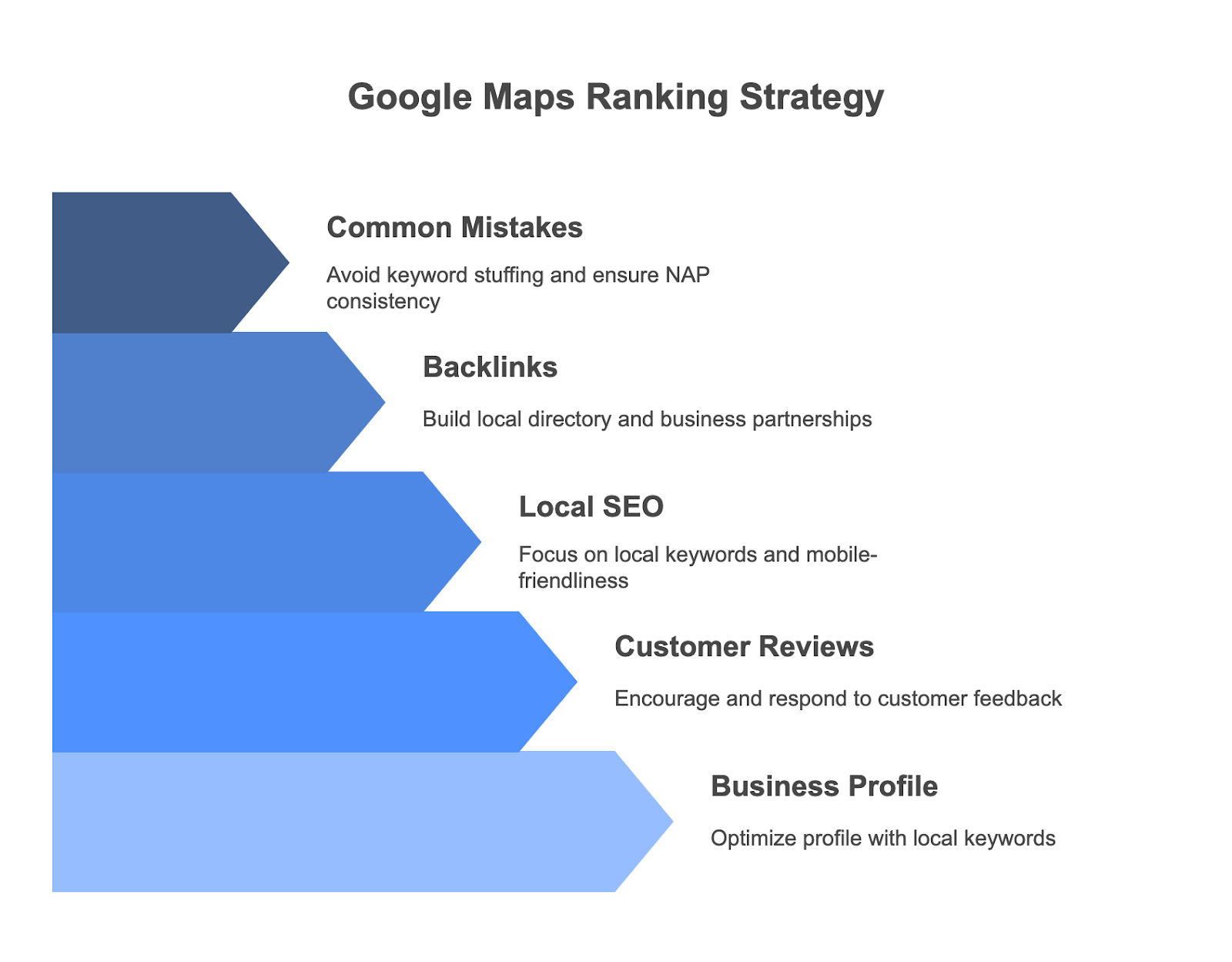
FAQs
Q. What can I do to raise my rating on Google Maps?
To raise your rating, focus on delivering excellent customer service and consistently request reviews from satisfied clients. Responding to reviews both positive and negative also shows engagement and builds trust.
Q. How can I enhance my ranking on Google?
Optimizing your Google Business Profile, building local citations, adding high-quality photos, responding to reviews, and embedding Google Maps on your website are all key to improving your local ranking.
Q. What steps can I take to achieve a higher position on Google Local Services?
Start by getting Google Guaranteed, collecting more reviews, ensuring NAP (Name, Address, Phone) consistency across the web, and targeting location-specific keywords in your content.
Q. Is it possible for me to modify my Google rating?
You can’t directly edit ratings, but you can improve your average score by collecting more positive reviews and addressing any negative feedback professionally to encourage updated or revised reviews.
Q. What number of reviews is necessary to boost my Google rating?
There’s no exact number, but consistency matters. Businesses with 20+ quality reviews often see a noticeable difference in both trust and visibility in the local pack.
Q. How can I attain a 5.0 rating on Google?
Offer top-tier service, follow up with clients for feedback, and request reviews from those who had great experiences. Avoid fake reviews and aim for authentic, happy customer responses.
Ready to Rank #1 on Google Maps?
Improving your Google Maps ranking for roofing services isn’t just about visibility; it’s about growing your business and attracting more customers. By optimizing your Google Business Profile, collecting reviews, implementing local SEO techniques, and building high-quality backlinks, you can climb to the top of the map pack and stay ahead of the competition.
Need expert guidance? Contact us today to schedule a consultation and take the guesswork out of improving your online presence. Let’s get your roofing business to the top of Google Maps!
17 Best Local SEO Strategies for Roofing Companies in 2025
Dominate Local Search in 2025: 17 Proven Local SEO Strategies for Roofing Companies
By 2025, 80% of local searches will result in a conversion, making Local SEO more critical than ever for roofing companies. If you’re not optimizing for local search, you’re leaving money on the table.

The good news? With the right strategies, you can dominate your local market and attract more customers than ever before. In this blog, we’ll share 17 actionable Local SEO strategies to help roofing companies thrive in 2025. But before we dive in, make sure you’re not making common mistakes. Check out our guide on 7 Local SEO Mistakes Roofing Companies Make and How to Fix Them. Ready to get started? Let’s dive in!
1. Optimize Your Google Business Profile (GBP)
Your Google Business Profile is your digital storefront. It’s often the first thing potential customers see when searching for roofing services.
Actionable Tips:
- Complete Every Section:
Fill out your business name, address, phone number (NAP), website, hours of operation, and services offered. A complete profile boosts your credibility and helps you rank higher.
- Add High-Quality Photos:
Showcase your work with before-and-after photos of roofing projects. Include images of your team, vehicles, and office to build trust.
- Enable Messaging and Booking:
Make it easy for customers to contact you directly through your GBP profile.
A roofing company optimized their GBP by adding 20+ photos and updating their business description. Within weeks, they started appearing in the local 3-pack (the top three businesses on Google Maps), leading to a 50% increase in calls.
2. Target Hyper-Local Keywords
Location-specific keywords help you attract nearby customers.
Actionable Tips:
- Use Keyword Research Tools:
Tools like Google Keyword Planner or Ubersuggest can help you find high-volume, low-competition keywords (e.g., “roofing company near me” or “emergency roof repair near me”).
- Create Dedicated Landing Pages:
For each service area, create a landing page with localized content and testimonials.
3. Build Local Citations
Local citations (mentions of your business name, address, and phone number) improve your visibility and credibility.
Actionable Tips:
- List Your Business on Directories:
Platforms like Yelp, Yellow Pages, and Angi are great places to start.
- Ensure NAP Consistency: Double-check that your NAP information is accurate and consistent across all directories.
4. Leverage Customer Reviews
Positive reviews are more than just feedback they’re a powerful tool to build trust with potential customers and boost your local rankings. When customers see glowing reviews, they’re more likely to choose your roofing company over competitors. Plus, search engines like Google prioritize businesses with high ratings and positive feedback, helping you rank higher in local search results.
Actionable Tips:
- Ask for Reviews: Encourage satisfied customers to leave reviews on Google and Yelp. Make it easy by sending a direct link to your review page via email or text.
- Respond to Reviews: Thank customers for positive reviews and address negative ones professionally.
5. Create Localized Content
Localized content resonates with your audience and boosts rankings.
Actionable Tips:
- Write Blog Posts:
Topics like “5 Signs You Need a Roof Repair” or “Top Roofing Trends in [Region]” can attract local traffic.
- Share Local Testimonials:
Highlight stories from local customers to build trust.
6. Use Local Schema Markup
Schema Markup is like a translator for search engines it helps them understand your business better. By adding structured data to your website, you can highlight key details like your business name, address, phone number, services, and customer reviews. This not only improves your chances of appearing in rich snippets (those eye-catching search results with extra info) but also boosts your local SEO efforts.
Actionable Tips:
- Add Structured Data:
- Include essential details like your business name, address, phone number (NAP), and services offered.
- Use schema types like LocalBusiness or Service to make your business stand out in search results.
- Use Tools:
- Google’s Structured Data Markup Helper is a free tool that walks you through the process step-by-step. Simply enter your website URL, select the type of data you want to markup, and tag the relevant elements.
- Validate your markup using Google’s Rich Results Test to ensure it’s error-free.
- Highlight Customer Reviews:
- Add AggregateRating schema to showcase your average rating and number of reviews.
- This can help you appear in rich snippets, making your listing more attractive to potential customers.
7. Optimize for Mobile Users
Did you know that over 60% of local searches happen on mobile devices? Whether someone is looking for emergency roof repairs or a reliable roofing company near them, they’re likely using their smartphone. If your website isn’t mobile-friendly, you’re missing out on a huge chunk of potential customers.
Ready to make your website mobile-friendly and attract more local leads? Contact us today for a free website audit and let’s transform your online presence to grow your business.
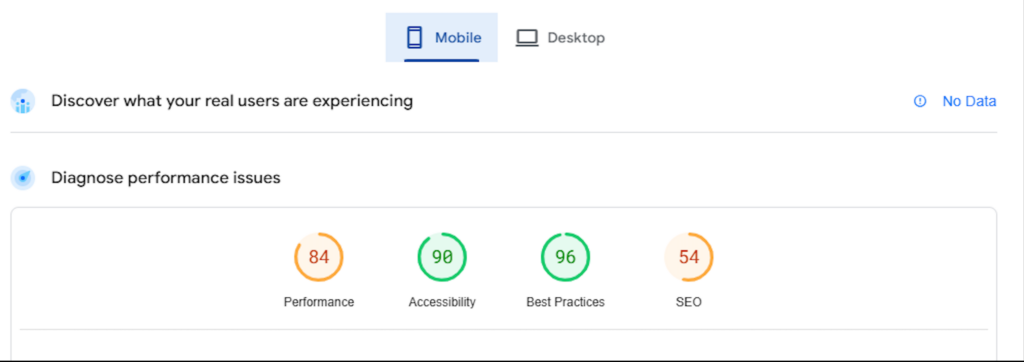
Actionable Tips:
- Ensure Mobile-Friendliness:
- Use a responsive design that automatically adjusts to fit any screen size, whether it’s a smartphone, tablet, or desktop.
- Test your website’s mobile performance using tools like Google’s Mobile-Friendly Test.
- Simplify Forms:
- Make it easy for customers to contact you by using large, tappable buttons and easy-to-read fonts.
- Keep forms short and straightforward—ask only for essential information like name, phone number, and email.
- Improve Page Speed:
- Mobile users expect fast-loading pages. Compress images, minimize code, and use a reliable hosting provider to speed up your site.
- Aim for a load time of under 3 seconds to keep users engaged.
8. Run Local PPC Campaigns
PPC (Pay-Per-Click) ads are a powerful way to boost your visibility in local searches. Unlike organic SEO, PPC allows you to appear at the top of search results almost instantly, making it ideal for roofing companies looking to attract customers quickly.
Actionable Tips:
- Target Location-Specific Keywords:
- Focus on keywords like “roofing services near me” or “emergency roof repair in [City].”
- Use negative keywords to avoid irrelevant clicks and save your budget.
- Use Ad Extensions:
- Add call extensions so customers can contact you directly from the ad.
- Include location extensions to show your address and make it easy for customers to find you.
- Highlight your services with sitelink extensions that link to specific pages on your website.
- Set a Local Radius:
- Target ads to a specific geographic area, such as a 10-20 mile radius around your business location.
- This ensures your ads are shown to potential customers in your service area.
9. Partner with Local Businesses
Local partnerships can lead to valuable backlinks.
Actionable Tips:
- Collaborate with Complementary Businesses:
Work with contractors, home improvement stores, or real estate agents.
- Sponsor Local Events: Build goodwill and earn backlinks by supporting community initiatives.
10. Use Video Marketing
Video content is engaging and ranks well in search results.
Actionable Tips:
- Create Project Showcases: Highlight before-and-after transformations.
- Share on Multiple Platforms: Post videos on YouTube, social media, and your website.
11. Monitor and Respond to Online Mentions
Your online reputation is crucial for attracting and retaining customers. When people talk about your roofing company online whether it’s on social media, review sites, or local blogs you need to know about it. Tracking mentions helps you stay on top of your reputation and respond promptly to both positive and negative feedback.
Actionable Tips:
- Use Monitoring Tools:
- Tools like Google Alerts, Mention, or Hootsuite can notify you whenever your business is mentioned online.
- Set up alerts for your business name, services, and even competitors to stay informed.
- Respond to Mentions:
- Thank customers for positive mentions and reviews it shows appreciation and builds loyalty.
- Address negative feedback professionally and offer solutions to turn the experience around.
- Engage with Your Audience:
- Join local community groups or forums where your business might be discussed.
- Share helpful tips or advice to position yourself as an industry expert.
12. Optimize for Voice Search
Voice search is growing rapidly, especially for local queries.
Actionable Tips:
- Target Conversational Keywords: Focus on phrases like “Who offers the best roofing services near me?”
- Improve Site Speed: Ensure your website loads quickly on all devices.
13. Build a Strong Social Media Presence
Social media helps you connect with local customers.
Actionable Tips:
- Share Visual Content: Post before-and-after photos, customer testimonials, and local news.
- Engage with Your Audience: Respond to comments and messages to build relationships.
14. Track Your Local SEO Performance
Monitoring performance helps you identify areas for improvement.
Actionable Tips:
- Use Analytics Tools:
Google Analytics and Search Console provide valuable insights.
- Track Key Metrics: Focus on traffic, rankings, and conversions.
15. Focus on E-A-T (Expertise, Authority, Trustworthiness)
Google prioritizes businesses that demonstrate E-A-T.
Actionable Tips:
- Showcase Expertise: Publish blog posts, case studies, and certifications.
- Build Authority: Earn backlinks from reputable sites.
16. Use AI-Powered SEO Tools
AI tools can streamline your Local SEO efforts.
Actionable Tips:
- Optimize Content: Tools like Surfer SEO or Clearscope can help you create high-performing content.
- Leverage AI for Research: Use AI to identify trends and track performance.
17. Stay Updated with Local SEO Trends
Local SEO is constantly evolving.
Actionable Tips:
- Follow Industry Blogs: Stay informed about the latest trends and updates.
- Attend Webinars: Learn from experts and network with peers.
FAQs
Q. What is the most effective approach for local SEO?
The best approach is to optimize your Google Business Profile, use local keywords, get positive reviews, and build local backlinks for better rankings.
Q. What is the most impactful advertising method for my roofing business?
A combination of Google Local Services Ads, Facebook Ads, and Local SEO ensures maximum visibility and lead generation.
Q. How can I improve my ranking in local SEO?
You can boost your ranking by focusing on NAP consistency, building local citations, earning high-quality backlinks, and optimizing your Google Business Profile with fresh content.
Q. How do I market my roofing company?
You can market your roofing company using Local SEO, PPC ads, content marketing, and social media while maintaining a strong reputation through customer reviews.
Q. What steps can I take to enhance my local SEO ranking?
If you follow these steps, you can enhance your local SEO ranking: Ensure on-page SEO optimization, improve site speed, use structured data, and encourage customer reviews to strengthen your rankings.
Q. How can I attract clients for my roofing services?
You can attract clients by leveraging SEO, local ads, social media marketing, and referral programs while maintaining a professional website and strong customer reviews.
Conclusion
Local SEO is no longer optional—it’s essential for roofing companies that want to thrive in 2025. By implementing these 17 strategies, you can dominate your local market, attract more customers, and grow your business.
Ready to take your Local SEO to the next level?
- Contact us today for a free consultation!
- Subscribe for more tips on staying ahead in 2025.
7 Local SEO Mistakes Roofing Companies Make (and How to Fix Them)
Don’t Let These Local SEO Mistakes Cost You Roofing Leads
Running a roofing company is no easy task. You’ve got the skills, the team, and the dedication to deliver top-notch services. But here’s the hard truth: If your Local SEO game isn’t strong, you’re likely missing out on a flood of potential customers.
Why? Because 48% of all Google searches are local. When someone types “roofing company near me” into their search bar, you want your business to be front and center. Unfortunately, many roofing companies make simple Local SEO mistakes that keep them buried in search results or worse, invisible altogether.
The good news? These mistakes are simple to correct. In this blog, we’ll reveal the top 7 Local SEO mistakes roofing companies often make and share practical solutions to help you take control of your local market. Ready to learn how other roofing companies increased leads by 200% with Local SEO? Let’s get started!
Mistake 1: Ignoring Google Business Profile (GBP) Optimization
Your Google Business Profile is your digital storefront. It’s often the first thing potential customers see when searching for roofing services. Yet, many roofing companies either don’t set it up or leave it incomplete.
A roofing company saw a 50% increase in calls after optimizing their GBP
The Fix:
- Complete Your Profile:
Make sure every section of your profile is complete. Include your business name, address, phone number (NAP), website, hours of operation, and a detailed list of services offered.
- Add High-Quality Photos:
Highlight your expertise by showcasing before-and-after photos of your roofing projects. Don’t forget to add images of your team, vehicles, and office. These personal touches help build trust with potential customers.
- Choose the Right Categories:
Select categories like “Roofing Contractor” and “Emergency Roof Repair” to ensure you appear in relevant searches.
Mistake 2: Neglecting Local Keywords
Many roofing companies target generic keywords like “roofing services” instead of location-specific ones. This makes it harder to attract local customers.
The Fix:
- Use Keyword Research Tools:
Tools like Google Keyword Planner or Ubersuggest can help you find high-volume, low-competition keywords (e.g., “roofing company near me” or “emergency roof repair near me”).
- Incorporate Keywords Naturally:
Use these keywords in your website content, meta descriptions, and blog posts.
Mistake 3: Inconsistent NAP Information
Having different business names, addresses, or phone numbers across directories confuses search engines and customers alike.
The Fix:
- Audit Your NAP Information:
Use tools like BrightLocal to find and fix inconsistencies.
- Ensure Consistency:
Make sure your NAP (Name, Address, Phone) information is identical on all platforms.
Mistake 4: Not Building Local Citations
Local citations (mentions of your business name, address, and phone number) are like digital referrals. They tell search engines that your business is legitimate and trustworthy. Yet, many roofing companies don’t list their business in local directories.
The Fix:
- List Your Business on Directories:
Platforms like Yelp, Yellow Pages, and Angi are great places to start.
- Ensure NAP Consistency:
Double-check that your information is accurate and consistent across all directories.
Mistake 5: Ignoring Customer Reviews
Did you know that 87% of consumers read online reviews before making a purchase decision? Failing to collect or respond to reviews hurts your credibility and local rankings.
The Fix:
- Ask for Reviews:
Make it a habit to ask your happy customers to share their experiences by leaving reviews on platforms like Google and Yelp.
- Respond to Reviews:
Always thank customers for positive reviews. It shows appreciation and builds loyalty. For negative reviews, respond professionally and offer solutions to turn the experience around.
Mistake 6: Overlooking Localized Content
Creating generic content that doesn’t resonate with local audiences is a missed opportunity.
The Fix:
- Write Localized Blog Posts:
Topics like “5 Signs You Need a Roof Repair” or “Top Roofing Trends in [Region]” can attract local traffic.
- Include Local Testimonials:
Share stories from local customers to build trust.
Mistake 7: Failing to Track Performance
Not monitoring your Local SEO efforts means you can’t measure success or identify areas for improvement.
The Fix:
- Use Analytics Tools:
Tools like Google Analytics and Search Console can help you track traffic, rankings, and conversions.
- Regularly Review Data:
Adjust your strategy based on performance data.
FAQs
Q. What is the main SEO mistake that companies most frequently make?
Ignoring Google Business Profile optimization is a major mistake, as it directly impacts local rankings. Many also fail to use local keywords, update citations, and gather customer reviews.
Q. What is the most significant challenge roofers encounter?
The biggest challenge is competing with well-established local businesses that dominate search results. Managing NAP consistency, customer reviews, and website SEO is also crucial for visibility.
Q. How can I resolve Local SEO problems for my roofing business?
Start by optimizing your Google Business Profile, fixing NAP inconsistencies, and building local citations. Focus on getting customer reviews, targeting local keywords, and ensuring a mobile-friendly website.
Q. Can negative reviews impact Local SEO for my roofing company?
Yes, too many negative reviews can harm rankings and trust, as Google considers them a ranking factor. Respond professionally to complaints and encourage happy customers to leave positive feedback.
Q. Why is my roofing company not appearing in local search results?
Possible reasons include an unoptimized Google Business Profile, inconsistent NAP details, or poor keyword targeting. Lack of customer reviews, weak website SEO, and slow site speed can also hurt rankings.
Q. What strategies can I use to advertise my roofing business?
Use a mix of Local SEO, Google Ads, social media marketing, and content marketing for visibility. Running Google Ads, optimizing your website, and leveraging referrals can generate quality leads.
Conclusion
Local SEO isn’t just a buzzword—it’s a game-changer for roofing companies. By avoiding these 7 common mistakes, you can significantly boost your online presence, attract more leads, and grow your business.
Ready to fix your Local SEO mistakes and dominate your local market?
- Contact us today for a free consultation!
- Subscribe for more tips on mastering local search.
How Roofing Companies Increased Leads by 200% with Local SEO
Imagine this: Several roofing companies were struggling to stand out in a competitive market. Despite offering excellent services, they were invisible online. Their competitors dominated local search results, and their phones rarely rang. Then, they discovered Local SEO. Within six months, their leads increased by 200%, and they became the go-to roofing companies in their areas.

If you’re a business owner or marketer in the roofing industry, you know how challenging it can be to attract local customers. But here’s the good news: You don’t need a massive marketing budget to dominate your local market. With the right Local SEO strategies, you can achieve similar results.
In this blog, we’ll walk you through the exact steps these roofing companies took to transform their businesses. By the end, you’ll have actionable tips to boost your online presence, generate more leads, and grow your roofing business. Let’s dive in!
Step 1: Optimize Google My Business (GMB) Profile
Your Google Business Profile is your digital storefront. It’s often the first thing potential customers see when they search for roofing services in their area. Here’s how to make it stand out:
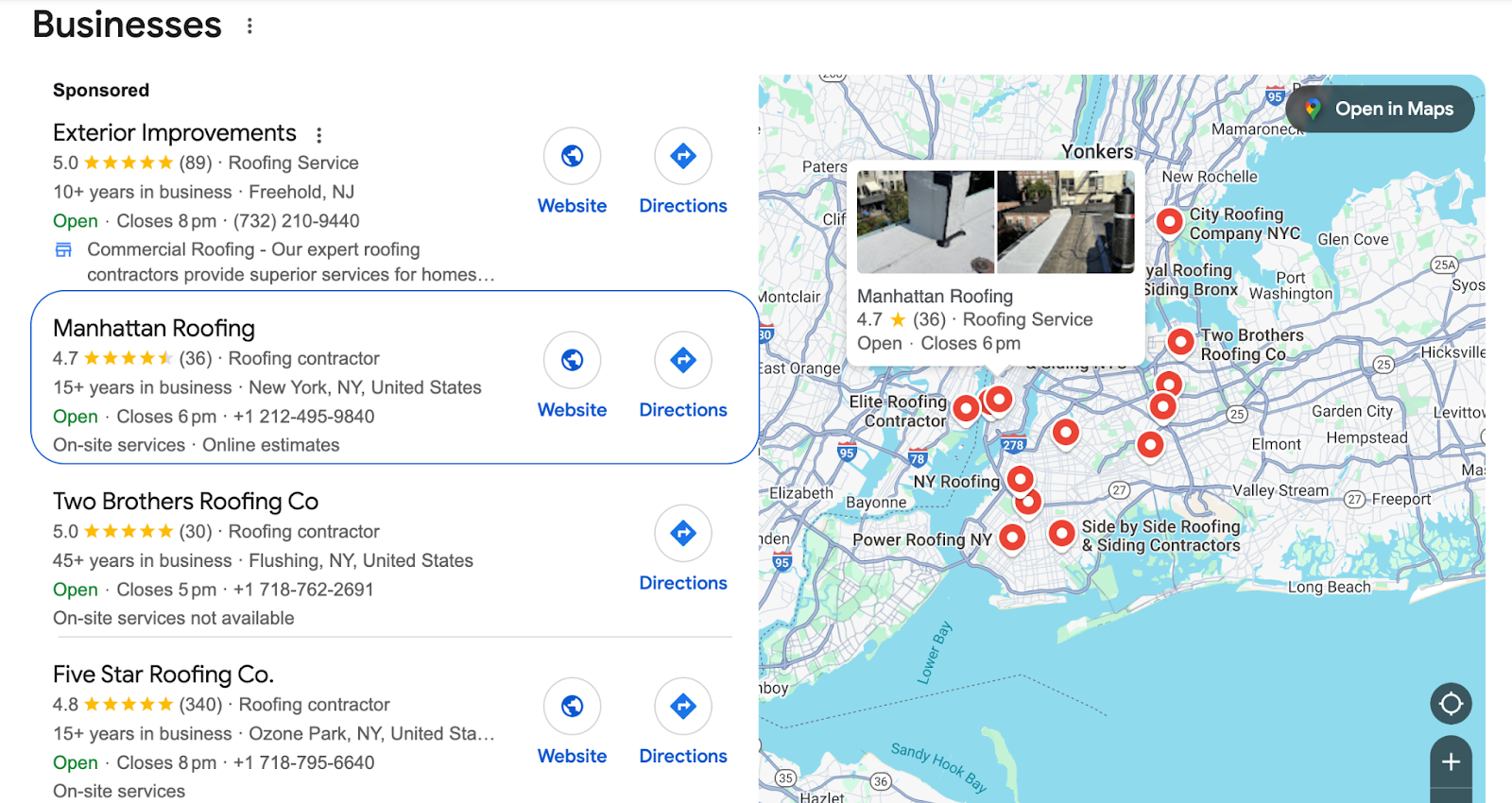
- Complete Your Profile:
Fill out every section business name, address, phone number (NAP), website, and hours of operation. Don’t forget to add a detailed business description with keywords like “roofing company near me.” - Add High-Quality Photos:
Showcase your work with before-and-after photos of roofing projects. Include images of your team, vehicles, and office to build trust. - Choose the Right Categories:
Select categories like “Roofing Contractor” and “Emergency Roof Repair” to ensure you appear in relevant searches. - Enable Messaging and Booking:
Make it easy for customers to contact you directly through your GMB profile.
Real-World Example:
Several roofing companies we worked with optimized their GBP by adding 20+ photos and updating their business descriptions. Within weeks, they started appearing in the local 3-pack (the top three businesses on Google Maps), leading to a 40% increase in calls.
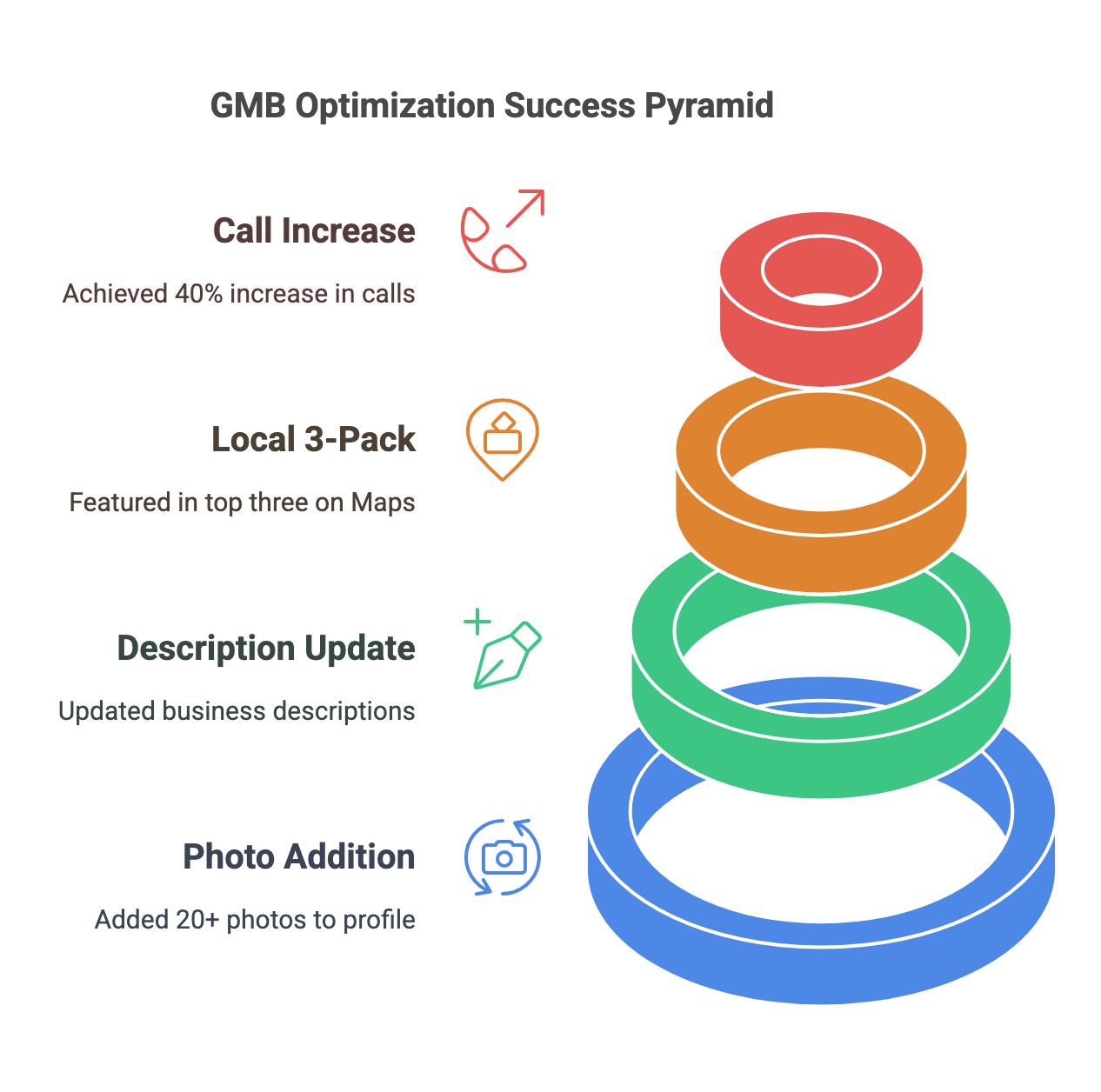
Step 2: Target Local Keywords
If you want to attract local customers, you need to speak their language. That means targeting location-specific keywords like:
- “Roofing company near me”
- “Emergency roof repair near me”
- “Affordable roofing services”
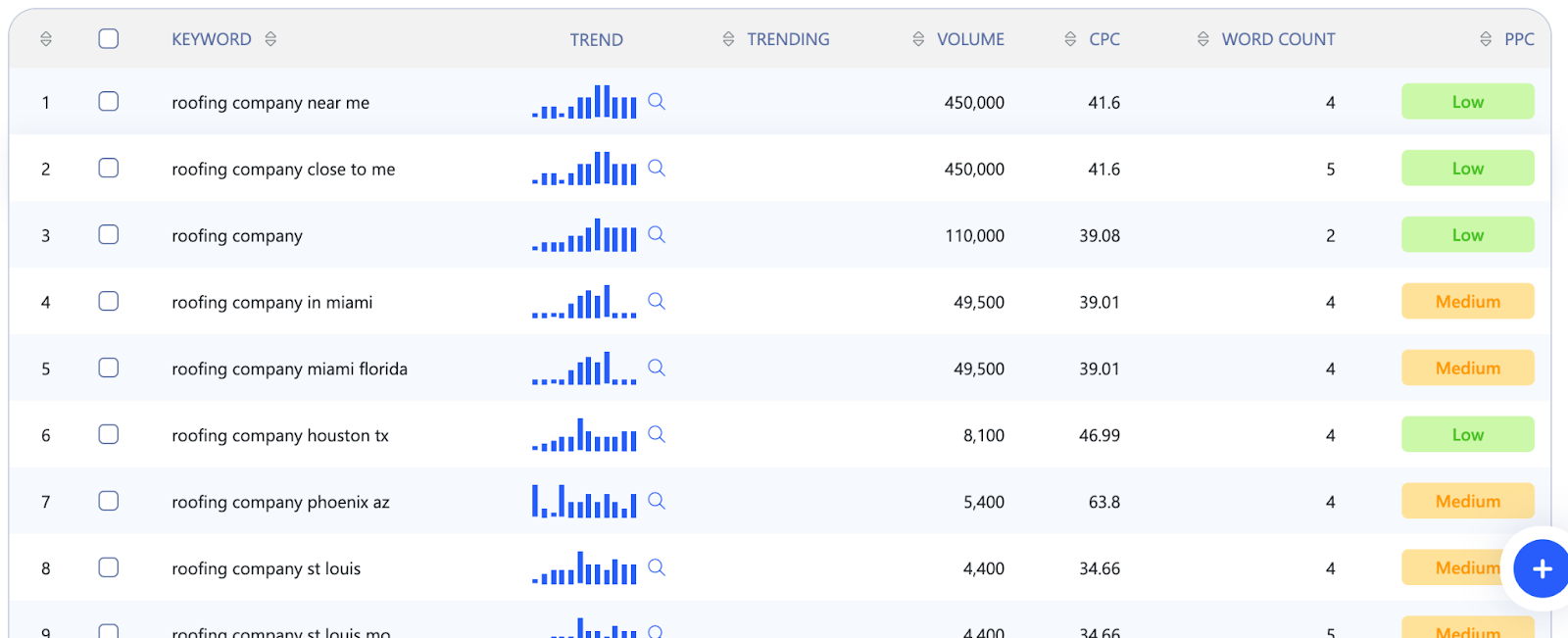
How to Find the Right Keywords:
To attract the right audience, you need to target the right keywords. Start by using tools like Google Keyword Planner or Ubersuggest to discover high-volume, low-competition keywords that align with your services.
Once you’ve identified these keywords, seamlessly integrate them into your website content, meta descriptions, and blog posts. This ensures your content is both search-engine-friendly and engaging for your audience.
Pro Tip: Create a dedicated landing page for each service area. For example, if you serve multiple locations, have a page titled “Roofing Services in [Service Area]” with localized content and testimonials.
Step 3: Build Local Citations and Backlinks
Local citations (mentions of your business name, address, and phone number) and backlinks (links from other websites to yours) are like digital referrals. They tell search engines that your business is legitimate and trustworthy.
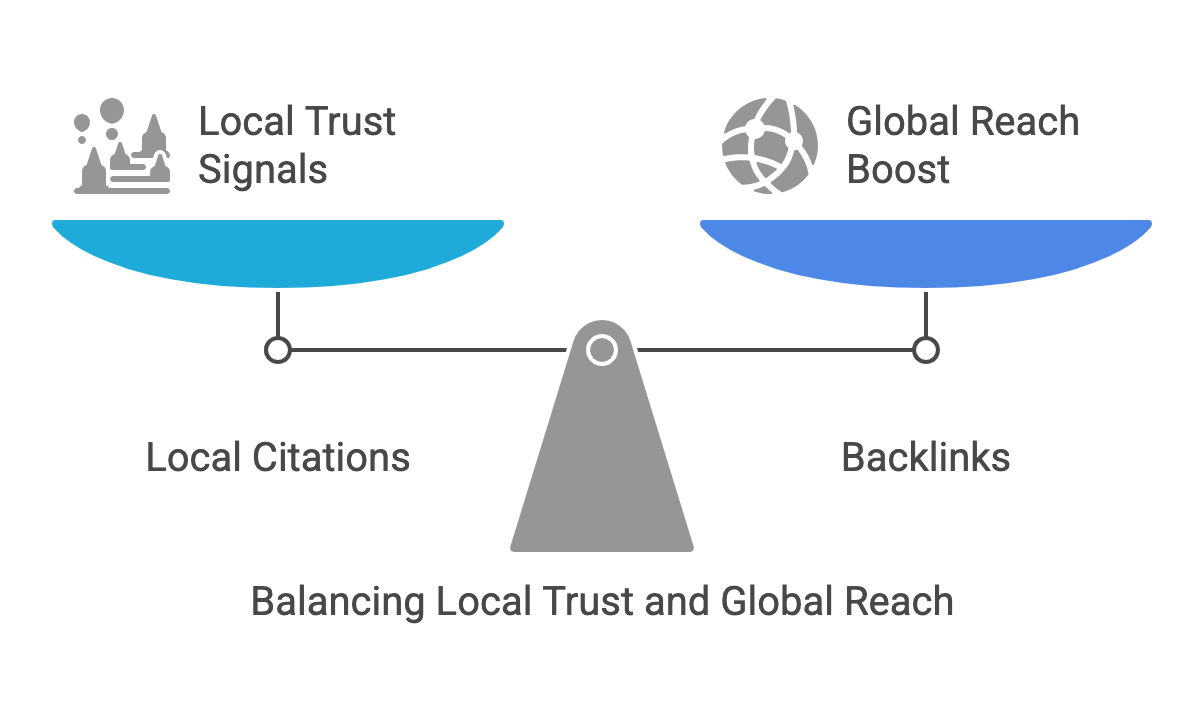
Where to List Your Business:
- Directories: Yelp, Yellow Pages, Angi, and HomeAdvisor.
- Industry-Specific Sites: Roofing associations or local business directories.
- Local Blogs and News Sites: Reach out to local bloggers or news outlets for features or guest posts.
How to Earn Backlinks:
- Partner with local businesses for cross-promotions.
- Write guest posts for local blogs or industry websites.
- Get featured in local news stories or community events.
Step 4: Leverage Customer Reviews
Did you know that 87% of consumers read online reviews before making a purchase decision? Positive reviews not only build trust but also improve your local rankings.
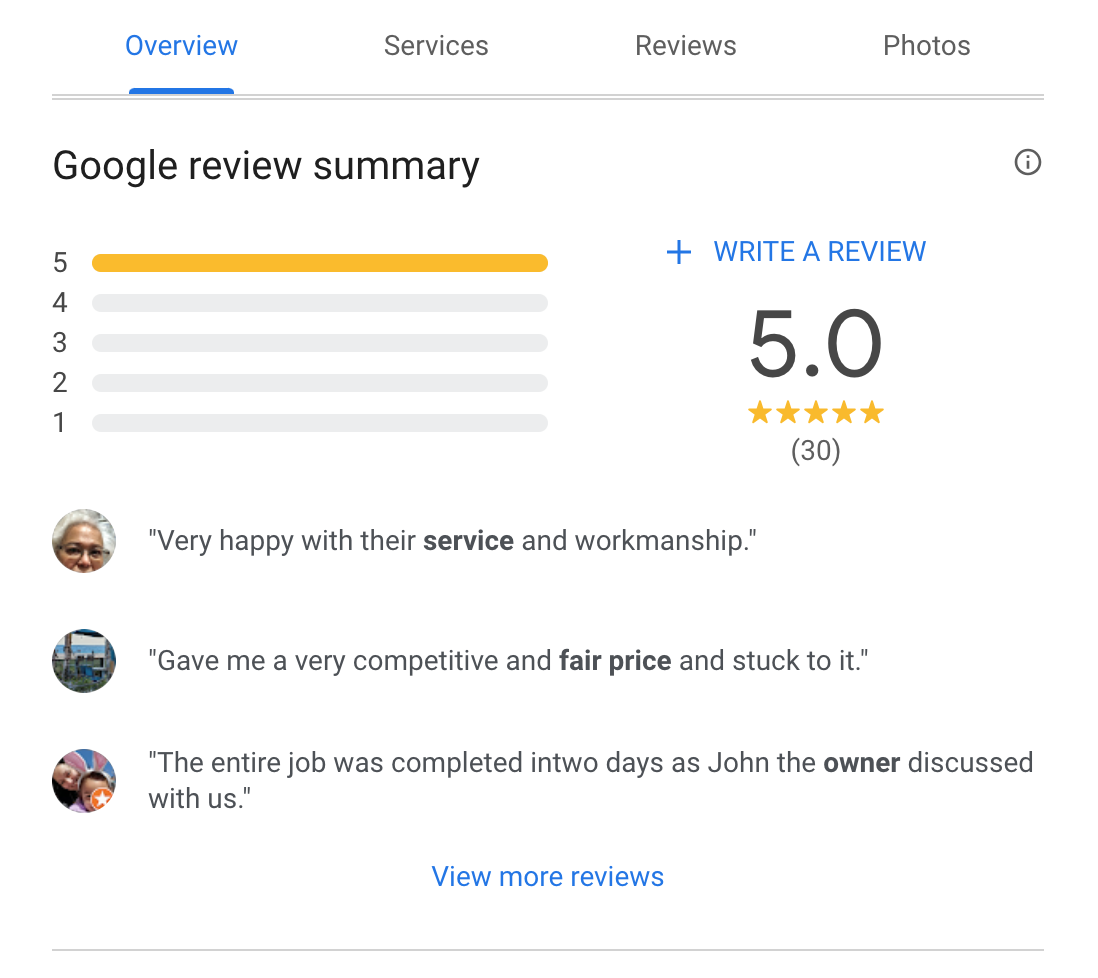
How to Get More Reviews:
- Ask satisfied customers to leave reviews on Google, Yelp, or Facebook.
- Make it easy by sending a direct link to your review page via email or text.
How to Respond to Reviews:
- Thank customers for positive reviews.
- Address negative reviews professionally and offer solutions.
Example:
Many roofing companies encouraged their happy customers to leave reviews by offering a 10% discount on their next service. Within three months, they had 50+ new reviews and a 4.8-star average rating.
Step 5: Create Localized Content
Content is king, but localized content is the ace up your sleeve. By creating content that resonates with your local audience, you can establish authority and attract more traffic.
Content Ideas for Roofing Companies:
- Blog posts: “5 Signs You Need a Roof Repair”
- Case studies: “How We Helped a Family Fix Their Leaky Roof”
- Community involvement: “Why We Sponsor Local Sports Teams”
Why It Works:
Localized content helps you rank for long-tail keywords and builds a connection with your audience. Many roofing companies published blog posts titled “Top 5 Roofing Problems Homeowners Face” and saw a 30% increase in website traffic from local searches.
FAQs
Q. Does SEO benefit roofing companies?
Yes, SEO helps roofing companies rank higher in local searches, attract more website visitors, and generate consistent leads. It improves visibility, credibility, and long-term business growth.
Q. What are the most effective platforms to market a roofing business?
Google Business Profile, local directories (Yelp, Angi), social media (Facebook, Instagram, LinkedIn), and SEO-optimized websites are key platforms. Google Ads can also drive quick leads.
Q. How can I increase leads for commercial roofing?
Optimizing your Google Business Profile, using location-based keywords, running PPC ads, and collecting reviews can boost commercial roofing leads. Content marketing and social proof also help.
Q. In what ways do roofers attract clients?
Roofers attract clients through SEO, paid ads, word-of-mouth referrals, social media, and online reviews. A strong online presence and high-quality service drive more inquiries.
Q. How can I obtain more prospects for my roofing company?
Improving local SEO, maintaining an active social media presence, running targeted ads, and leveraging customer testimonials can bring in more prospects.
Q. What strategies can I use to advertise my roofing business?
The best strategies include Local SEO, Google and Facebook Ads, referral programs, and video marketing. Posting before-and-after project photos and testimonials builds trust.
Conclusion
Local SEO isn’t just a buzzword—it’s a game-changer for roofing companies. By optimizing your Google Business Profile, targeting local keywords, building citations, leveraging reviews, and creating localized content, you can significantly boost your leads and grow your business.
The roofing companies in our case studies achieved a 200% increase in leads by following these steps. Now, it’s your turn to take action.
Ready to transform your roofing business?
- Subscribe for more tips and strategies.
- Comment below to share your thoughts or ask questions.
- Contact us today to get started with expert SEO services tailored to your business.